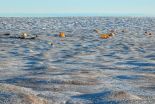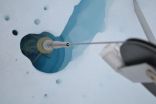(Press-News.org) An international research team's field work, drilling and measuring melt rates and ice sheet movement in Greenland is showing that things are, in fact, more complicated than we thought.
"Although the Greenland Ice Sheet initially speeds up each summer in its slow-motion race to the sea, the network of meltwater channels beneath the sheet is not necessarily forming the slushy racetrack that had been previously considered," said Matthew Hoffman, a Los Alamos National Laboratory scientist on the project.
A high-profile paper appearing in Nature this week notes that observations of moulins (vertical conduits connecting water on top of the glacier down to the bed of the ice sheet) and boreholes in Greenland show that subglacial channels ameliorate the speedup caused by water delivery to the base of the ice sheet in the short term. By mid summer, however, the channels stabilize and are unable to grow any larger. In a previous paper appearing in Science, researchers had posited that the undersheet channels were not even a consideration in Greenland, but as happens in the science world, more data fills in the complex mosaic of facts and clarifies the evolution of the meltwater flow rates over the seasons.
In reality, these two papers are not inconsistent - they are studying different places at different times - and they both are consistent in that channelization is less important than previously assumed, said Hoffman.
The Greenland Ice Sheet's movement speeds up each summer as melt from the surface penetrates kilometer-thick ice through moulins, lubricating the bed of the ice sheet. Greater melt is predicted for Greenland in the future, but its impact on ice sheet flux and associated sea level rise is uncertain: direct observations of the subglacial drainage system are lacking and its evolution over the melt season is poorly understood.
"Everyone wants to know what's happening under Greenland as it experiences more and more melt," said study coauthor Ginny Catania, a research scientist at the institute and an associate professor in the University of Texas at Austin's Jackson School of Geosciences. "This subglacial plumbing may or may not be critical for sea level rise in the next 100 years, but we don't really know until we fully understand it."
To resolve these unknowns, the research team drilled and instrumented 13 boreholes through 700-meter thick ice in west Greenland. There they performed the first combined analysis of Greenland ice velocity and water pressure in moulins and boreholes, and they determined that moulin water pressure does not lower over the latter half of the melt season, indicating a limited role of high-efficiency channels in subglacial drainage.
Instead they found that boreholes monitor a hydraulically isolated region of the bed, but decreasing water pressure seen in some boreholes can explain the decreasing ice velocity seen over the melt season.
"Like loosening the seal of a bathtub drain, the hydrologic changes that occur each summer may cause isolated pockets of pressurized water to slowly drain out from under the ice sheet, resulting in more friction," said Hoffman.
Their observations identify a previously unrecognized role of changes in hydraulically isolated regions of the bed in controlling evolution of subglacial drainage over summer. Understanding this process will be crucial for predicting the effect of increasing melt on summer speedup and associated autumn slowdown of the ice sheet into the future.
INFORMATION:
The research letter is published in this week's Nature magazine as "Direct observations of evolving subglacial drainage beneath the Greenland Ice Sheet." The project was an international collaboration between the University of Texas at Austin, Los Alamos National Laboratory, NASA Goddard Space Flight Center, Michigan Technological University, University of Zurich, the Swiss Federal Institute of Technology and Dartmouth College.
This project was supported by United States National Science Foundation, the Swiss National Science Foundation and the National Geographic Society. The work at Los Alamos was supported by NASA Cryospheric Sciences, and through climate modeling programs within the US Department of Energy, Office of Science.
Los Alamos National Laboratory, a multidisciplinary research institution engaged in strategic science on behalf of national security, is operated by Los Alamos National Security, LLC, a team composed of Bechtel National, the University of California, The Babcock & Wilcox Company, and URS for the Department of Energy's National Nuclear Security Administration.
Los Alamos enhances national security by ensuring the safety and reliability of the U.S. nuclear stockpile, developing technologies to reduce threats from weapons of mass destruction, and solving problems related to energy, environment, infrastructure, health, and global security concerns.
VIDEO:
NASA's TRMM satellite saw Phanfone was producing rainfall over a very large area on Oct. 1. Some storms in these bands were dropping rain at a rate of over 76...
Click here for more information.
An intensifying typhoon called Phanfone that originated east of Guam on September 28, 2014 is headed toward southern Japan. The TRMM satellite crossed above Typhoon Phanfone on October 1, 2014 at 1039 UTC and gathered data about rainfall rates occurring in the storm.
TRMM, ...
The monarch butterfly is one of the most iconic insects in the world, best known for its distinct orange and black wings and a spectacular annual mass migration across North America. However, little has been known about the genes that underlie these famous traits, even as the insect's storied migration appears to be in peril.
Sequencing the genomes of monarch butterflies from around the world, a team of scientists has now made surprising new insights into the monarch's genetics. They identified a single gene that appears central to migration – a behavior generally regarded ...
To protect their gut microbes during illness, sick mice produce specialized sugars in the gut that feed their microbiota and maintain a healthy microbial balance. This protective mechanism also appears to help resist or tolerate additional harmful pathogens, and its disruption may play a role in human diseases such as Crohn's disease, report scientists from the University of Chicago in Nature on Oct 1.
"Both hosts and their gut microbiota can suffer in the case of sickness, but this mutually beneficial relationship is guarded by the host," said study senior author Alexander ...
Chemicals released into the air by oil and gas exploration, extraction and related activities can spark reactions that lead to high levels of ozone in wintertime, high enough to exceed federal health standards, according to new NOAA-led research, published today in Nature.
The study comes at a time when new technologies are helping to accelerate oil and gas development in Utah's Uintah Basin, elsewhere in the United States and in many other countries, and its findings may help air quality managers determine how to best minimize the impact of ozone pollution.
When ozone ...
AUSTIN, Texas—A team led by scientists at the University of Texas at Austin's Institute for Geophysics has for the first time directly observed multiple parts of Greenland's subglacial plumbing system and how that system evolves each summer to slow down the ice sheet's movement toward the sea.
These new observations could be important in accurately modeling Greenland's future response to climate change.
"Everyone wants to know what's happening under Greenland as it experiences more and more melt," said study coauthor Ginny Catania, a research scientist at the institute ...
Titan is unique in our solar system because of its dense nitrogen-methane atmosphere, which is very similar to Earth's in some ways, but very different in others. For example, air temperatures are around 200 degrees colder and, in contrast to the warm salt water seas of Earth, frigid hydrocarbon lakes populate Titan's surface.
Titan has seasons just like Earth, only each season lasts over seven years instead of three months due to its ponderous orbit around the Sun. After equinox in 2009, Titan's south pole entered the perpetual darkness of polar winter. Soon after, ...
New data obtained by NASA's GRAIL mission reveals that the Procellarum region on the near side of the moon — a giant basin often referred to as the "man in the moon" — likely arose not from a massive asteroid strike, but from a large plume of magma deep within the moon's interior.
The Procellarum region is a roughly circular, volcanic terrain some 1,800 miles in diameter — nearly as wide as the United States. One hypothesis suggested that it was formed by a massive impact, in which case it would have been the largest impact basin on the moon. Subsequent asteroid collisions ...
PROVIDENCE, R.I. [Brown University] — Oceanus Procellarum, a vast dark patch visible on the western edge of the Moon's near side, has long been a source of mystery for planetary scientists. Some have suggested that the "ocean of storms" is part of a giant basin formed by an asteroid impact early in the Moon's history. But new research published today in Nature deals a pretty big blow to the impact theory.
The new study, based on data from NASA's GRAIL mission, found a series of linear gravitational anomalies forming a giant rectangle, nearly 1,600 miles across, running ...
CINCINNATI – Researchers developed a new type of cell transplantation to treat mice mimicking a rare lung disease that one day could be used to treat this and other human lung diseases caused by dysfunctional immune cells.
Scientists at Cincinnati Children's Hospital Medical Center report their findings in a study posted online Oct. 1 by Nature. In the study, the authors used macrophages, a type of immune cell that helps collect and remove used molecules and cell debris from the body.
They transplanted either normal or gene-corrected macrophages into the respiratory ...
CAMBRIDGE, Mass--Error-correcting codes are one of the glories of the information age: They're what guarantee the flawless transmission of digital information over the airwaves or through copper wire, even in the presence of the corrupting influences that engineers call "noise."
But classical error-correcting codes work best with large chunks of data: The bigger the chunk, the higher the rate at which it can be transmitted error-free. In the Internet age, however, distributed computing is becoming more and more common, with devices repeatedly exchanging small chunks of ...




